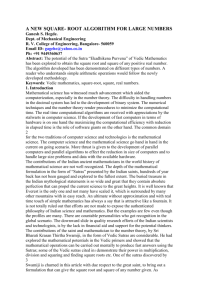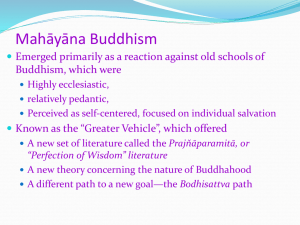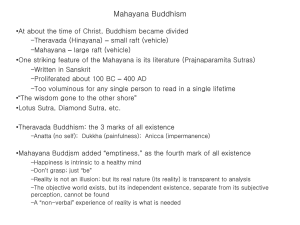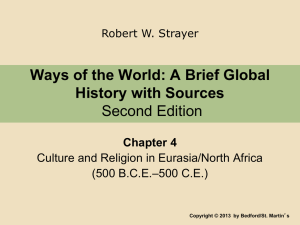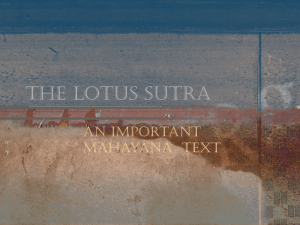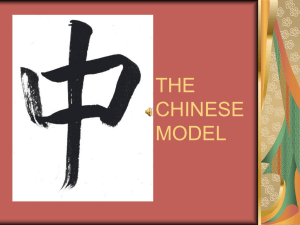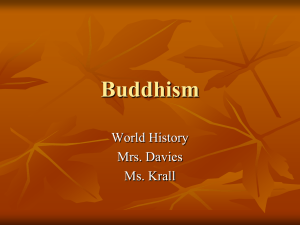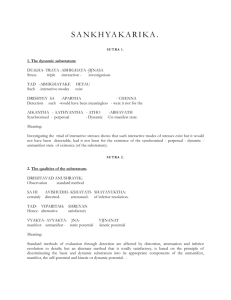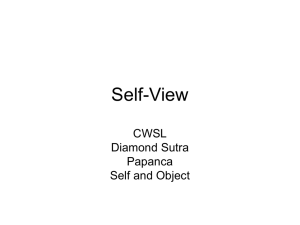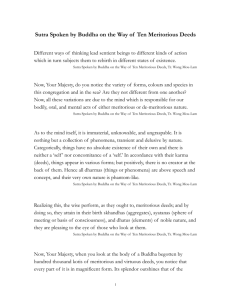Speech28072011
advertisement
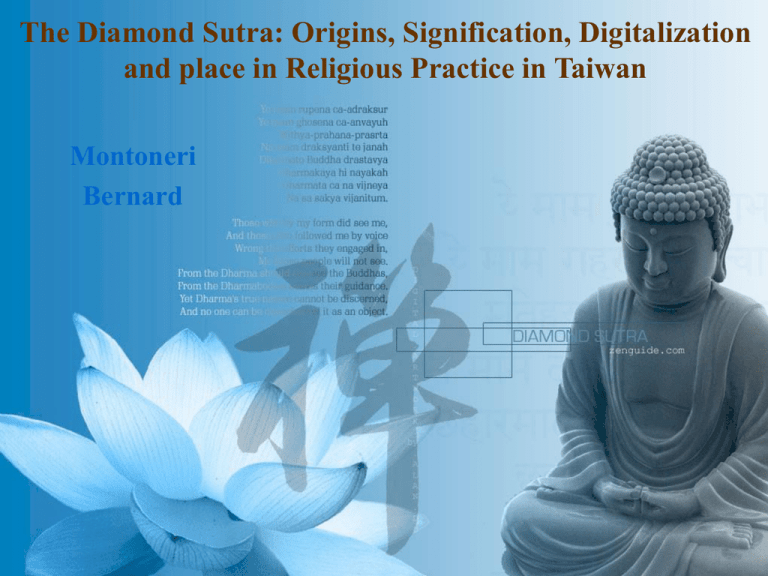
The Diamond Sutra: Origins, Signification, st The Diamond Sutra in the 21Digitalization and place in Religious Practice in Taiwan Century Montoneri Bernard 2015/4/10 Dr. Montoneri 1 The Diamond Sutra: Origins, Signification, Digitalization and place in Religious Practice in Taiwan Outline Introduction I. Presentation of the sutra II. Socio-historical evolution III. Signification IV. Corrections et digitalization V. Place in religious practice in Taiwan Conclusion References 2015/4/10 Dr. Montoneri 2 Introduction The Diamond Sutra belongs to the Mahāyāna sūtras, the Prajñāpāramitā genre ("Perfection of Wisdom"). The Mahāyāna is the "Great Vehicle", one of the two main existing branches of Buddhism. This sūtra was probably written in India during the 2nd century AD. The most ancient Chinese translation, by Kumarajiva, dates from around 407. The Diamond Sutra is particularly important in China and in Taiwan, for socio-historical, religious and philosophical reasons. 2015/4/10 Dr. Montoneri 3 Introduction This dialogue in 32 sections between Buddha and his disciple Subhuti is one of the most studied sacred texts. The digitalization of the Diamond Sutra has helped scholars around the world to study it. There is a wood block printed copy in the British Library which dates from 868, almost 6 centuries before the Gutenberg Bible was first printed. This text is now online. 2015/4/10 Dr. Montoneri 4 I. Presentation of the sutra Title In Sanskrit: Vajracchedikā Prajñāpāramitā Sūtra . In Chinese: 金 剛 般 若 波 羅 蜜 多 經 jīngāng bōrě bōluómìduō jīng ou 金剛經 Jīngāngjīng. In English: Diamond-Cutter Sutra of the Perfection of Wisdom. Origins Sutra written by Indian monks 2nd century AD. Zhi Qian 支謙 is the first translator but his version is now lost (3rd century). 2015/4/10 Dr. Montoneri 5 The sutra has been translated into Chinese by 6 monks : Kumarajiva (~407) Bodhiruci (Beginning 6th century) Paramartha (~562) Dharmagupta (~605-617) Xuanzang (~660-663) Yijing (~703) Painting of Xuanzang 2015/4/10 Dr. Montoneri 6 I. Presentation of the sutra Meaning of the sutra’s name Vajra means “diamond”. It is an important symbol, notably in Mahāyāna and Vajrayāna. It is about power and stability. Buddhists consider vajra as a symbol of what cannot be destroyed. This symbol is connected to the notion of emptiness. Finally, vajra is linked to the idea that Buddha is trying to help Subhūti unlearn his preconceived, limited notions of the nature of reality and enlightenment. 2015/4/10 Dr. Montoneri 7 I. Presentation of the sutra Vajracchedikā means more “indestructible cutter” than “diamond”. The cutter is here a mental attitude, a weapon cutting through the dualistic vision of the world. Prajñāpāramitā means “Perfection of Wisdom”. Prajñā is one of the six virtues (pāramitā) that a Bodhisattva should cultivate: wisdom. The main goal for the Buddha to be is to transcend the dualistic vision of the world, to cut through illusions. 2015/4/10 Dr. Montoneri 8 I. Presentation of the sutra Sūtra refers mostly to canonical scriptures, many of which are regarded as records of the oral teachings of Gautama Buddha. In Chinese, these are known as 經 (pinyin: jīng). Oral transmission of the teachings during the 4 first centuries after Buddha’s death (around 480 BC). Sūtras are most often lengthy, with many repetitions which serve the mnemonic purpose of the audience. Some 600 Mahayana Sutras have survived in Sanskrit, or in Chinese and/or Tibetan translation. The style of sūtras is simple, clear, didactical and often repetitive. 2015/4/10 Dr. Montoneri 9 Chung Tai Chan Monastery 中台禪寺 2015/4/10 Dr. Montoneri 10 II. Evolution socio-historique The Diamond Sutra has been famous since its introduction in China: translated and commented upon numerous times. Under the dynasty of the Tang 唐 (618-907), there were more than 800 commentaries and interpretations of the Vajracchedika. Under the dynasty of the Song 宋 (960-1279), the sutra was part of the required programme for entrance examens in schools and to become monk. One can also measure the influence of the 金剛經 Jinganging in China by looking at the manuscripts discovered in Dunhuang (Gansu). 2015/4/10 Dr. Montoneri 11 II. Evolution socio-historique Wood block printing probably began in China in the 7th century. An official document from December 29, 835 contains a mention of the existence of printing. it was Buddhism that played the strongest role in influencing writing and, in particular, printing. During the Sui Dynasty (581-618 AD), Buddhism enjoyed an explosion in the production of printed texts. A version of the Diamond Sutra from 868 was discovered by Sir Aurel Stein in 1907 at Dunhuang and sent to London. 2015/4/10 Dr. Montoneri 12 II. Evolution socio-historique Thus wood block printed copy is now in the British Museum. Although not the earliest example of block printing, it is the earliest example which bears an actual date. “Reverently made for universal free distribution by Wang Jie on behalf of his two parents on the 15th of the 4th moon of the 9th year of Xiantong.” [11 May 868] Printed during the Tang Dynasty (懿宗 Yizong, 859873). The sutra was respectfully printed by Wang Jie 王玠 for his parents. 2015/4/10 Dr. Montoneri 13 British Museum-Diamond Sutra, 868 AD 2015/4/10 Dr. Montoneri 14 Nanjing, centre of publication of Buddhist sutras, Jinling (金陵刻經處). The centre owns more than 100 000 engraved texts. 2015/4/10 Dr. Montoneri 15 III. Signification Accumulation of merits The Diamond Sutra insists on the theme of accumulation of merits: in the Buddhist tradition, to copy sutras is an act of devotion, publicly or privately. Mahāyāna did not have monks exclusively formed to memorize sutras. Most of the believers of the Great Vehicle laymen and women . They all had a family and could not spend all their time memorizing and preserving sutras. Therefore, there is great emphasis in this group of sutra on the accumulation of merits for people who would copy, memorize and comment upon the sutra. 2015/4/10 Dr. Montoneri 16 III. Signification Accumulation of merits The Buddha said to Subhuti: “If a good man or good woman is able to comprehend and follow a four-line verse of this sutra and teach it to others, their merit will be far greater.” The transmission of Buddha’s Teaching is the greatest donation (dana, virtue of generosity). The accumulation of merits is right, as long as the believer understands the Doctrine. 2015/4/10 Dr. Montoneri 17 III. Signification Accumulation of merits Here is the story of Zhao Wenchang 趙文昌: when he died, he appeared in front of Yama, the the lord of death. Zhao declared that among his good deeds, he had a perfect knowledge of the Diamond Sutra. Yama sent him to the Infernal Library to find a copy of the sutra. Zhao found the sutra in the Library and was able to recite the entire text without making any mistake. (Drège-1991, pp.210-211 ) 2015/4/10 Dr. Montoneri 18 III. Signification Emptiness The central method preached is asthanayoga (nonattachment): to fix our attention on nothing. Meditation on emptiness is the remedy to wrong beliefs: concentration on the double inexistence of beings and things. The Buddhist term emptiness (śūnyatā) refers specifically to emptiness of inherent existence. A human being is a part of the whole, called by us "Universe," a part limited in time and space. He experiences himself, his thoughts and feelings as something separate from the rest—a kind of optical delusion of his consciousness. The striving to free oneself from this delusion is the one issue of true religion. Not to nourish it but to try to overcome it is the way to reach the attainable measure of piece of mind. (February 12, 1950 Albert Einstein) 2015/4/10 Dr. Montoneri 19 Subhūti Subhūti was one of the Ten Great disciples of Buddha, and foremost in the understanding of emptiness. In Sanskrit, his name literally means "Good Existence" (su: "good", bhūti: "existence"). 2015/4/10 Dr. Montoneri 20 III. Signification The six perfections The six pāramitā sont Dana (generosity), Śīla (virtue, honesty), Kṣānti (patience), Vīrya (energy), Dhyāna (meditation) and Prajñā (wisdom). The bodhisattva possesses the qualities of compassion and benevolence towards all the beings he/she tries to save. The virtues should be cultivated in order to get rid of the 6 obstacles: greed, immorality, hostility, laziness, distraction and wrong views. The first 3 virtues produce wealth, excellent physical condition and good company respectively. The 3 other virtues tame the klesa (attachment, ignorance), mature beings and eliminate the dualistic vision of the world. 2015/4/10 Dr. Montoneri 21 III. Signification OM Dāna pāramitā 布施波羅蜜 bùshī pōluómì generosity MA Śīla pāramitā 持戒波羅蜜 chíjié pōluómì virtue, honesty NI Kṣānti pāramitā 忍辱波羅蜜 rěnrù pōluómì patience, tolerance PAD Vīrya pāramitā 精進波羅蜜 jīngjìn pōluómì energy, effort, courage ME Dhyāna pāramitā 禪定波羅蜜 chándìng pōluómì concentration, meditation HUM Prajñā pāramitā 智慧波羅蜜 zhìhuì pōluómì wisdom 2015/4/10 Dr. Montoneri 22 Dhyāna Virtue of meditation A Monastary near Taidong 2015/4/10 Dr. Montoneri 23 IV. Corrections and digitalization The Taisho contains 8 Chinese translations of the Diamond Sutra, by 6 monks. During the digitalization process, it is vital to correct the numerous errors found in the printed version. For example, T.236b is attributed to Bodhiruci. It is in fact Paramartha’s translation. T.1510b is wrongly attributed to Dharmagupta. It was translated by Bodhiruci. It is a commentary by Asanga quoting the entire sutra. 2015/4/10 Dr. Montoneri 24 IV. Corrections and digitalization The 8 Chinese texts included in the Taisho The 8 texts in the Taisho Translator Date of translation T.235 Kumarajiva 407 T.236a, pp.752 c-757 a. Bodhiruci 509 T.236b, pp.757 a-761 c. Paramartha Beginning 6th century T.237 Paramartha 562 T.1510b Bodhiruci 600 T.238 Dharmagupta 605-617 T.220 Xuanzang 660-663 T.239 Yijing 703 2015/4/10 Dr. Montoneri 25 IV. Corrections and digitalization The Diamond Sutra-Online versions Sanskrit version online USA Chinese version online Taiwan Thesaurus Literaturae Buddhicae (site) Norway Database of Chinese Buddhist Texts (site) Japan Internet Sacred Text Archive (site) USA Chinese with English Translation (site) Japan Different versions online USA Foundation for the Preservation of the Mahayana Tradition 2015/4/10 Dr. Montoneri 26 IV. Corrections and digitalization Digitalization project and online version Collect all the available Sanskrit, Chinese and Western versions and post them online. Correct them, notably the punctuation problem. Translated the original text in English and French. Writing the bio of the 6 translators. Offer a commentary of the sutra (video; Power Point). Making a Sanskrit-Chinese-English glossary. Reading and analysis of the Chinese versions. Links to other sites and bibliography. 2015/4/10 Dr. Montoneri 27 Lewis Lancaster – 10th anniversary of CBETA 2015/4/10 Dr. Montoneri 28 Conference guests from February 15-17, 2008 2015/4/10 Dr. Montoneri 29 V. Place in religious practice in Taiwan The Diamond Sutra is especially famous Taiwan, in all the schools of Buddhism and in all temples. Here is a presentation of section 1 and an analysis of the relation between Buddha’s teaching and Qigong. Qigong 氣功 comes from Taoist exercises to aimed at increasing the energy of life. Qigong was also influenced by Buddhism and is part of Chinese medicine. 氣 qi: vital energy et 功 gong (exercise, discipline). Two examples: abdominal breathing, and meditation. 2015/4/10 Dr. Montoneri 30 V. Place in religious practice in Taiwan Section 1 Thus I have heard. Once, the Buddha was staying in the Anathapindada’s Park at Jeta Grove in Shravasti, with a community of 1,250 bhiksus. When it was mealtime, the World Honored One put on his robe, took his alms-bowl, and went into the great city of Shravasti, going from house to house to beg for food. This done, he returned to his abiding place, finished the meal, put away his robe and bowl, washed his feet, arranged his seat, and sat down. 2015/4/10 Dr. Montoneri 31 V. Place in religious practice in Taiwan Subhuti is amazed by the way Buddha offers his teaching. His daily activities resemble those of any monk to the point that few realize the extraordinary quality of the master and his teaching. Subhuti perceives immediately that Buddha protects and leads to deliverance all beings with compassion and wisdom. In fact, Buddha lives a very simple life, wakes up, dresses up and goes to the city to beg for some rice for lunch. After lunch, Buddha goes to the park and enters a state of deep meditation. 2015/4/10 Dr. Montoneri 32 V. Place in religious practice in Taiwan The sutra’s insistence on the simple life style of Buddha is fundamental . He fixes his attention on his breathing and enters a state of meditation. This attitude is common to Buddhism and Qigong: it is called Satipatthana (establishment of attention). This deep vigilance is essential to attain enlightenment and is associated to wisdom (prajñā). Buddha fixes his attention on daily and ordinary acts. As a result, they become extraordinary. He has a clear consciousness of things and of events. Qigong practitioners learn to concentrate their thoughts, to relax and to fix their attention on nothing in particular. For example, new born children know how to do abdominal breathing, while most of the adults concentrate on their lungs to breath. 2015/4/10 Dr. Montoneri 33 V. Place dans la pratique religieuse à Taiwan Qigong practitioners are often attracted to Buddhism. In a Qigong state, it happens that practitioners spontaneously recite Buddhist sutras. It is also possible to see images of Buddhas and bodhisattvas, for example 觀音 Guanyin, 彌勒佛 Milefo, 燃燈佛 Ran deng Fo, 藥師佛 Yaoshi Fo. Some adepts look for causes of their illness in past lives. All beings are caught in the samsara (cycle of reincarnations), our present life is conditioned to the sum of good and bad deeds from our past lives. In Chinese tradition, the fifteenth day of the seventh month in the lunar calendar is called Ghost Day and the seventh month in general is regarded as the Ghost Month (鬼月), in which ghosts and spirits, including those of the deceased ancestors, come out from the lower realm. 2015/4/10 Dr. Montoneri 34 V. Place dans la pratique religieuse à Taiwan Taiwanese people are interested in astrology, past lives, spirits, Feng Shui, La ligne directrice du Feng Shui est l'optimisation des “flux de qi”. There are numerous TV programs, such as 命運好好玩 (site). The most famous Taiwanese Qigong and 功夫 Kungfu Master 李鳳山 Lee Feng-san (site). In 1987, Lee Feng-san and the NSC in Taiwan, experiments to scientifically demonstrate the existence of the “Qi”. The practitioners of his centre 梅門 Mei-Men are Buddhists and Lee insists on the importance of being a vegetarian. Physical et spirituals exercises are insufficient. To cure, one has to change his attitude, his state of mind, his character, and the way he sees the world. 2015/4/10 Dr. Montoneri 35 Lee Feng-san 李鳳山 2015/4/10 Dr. Montoneri 36 Science Museum-Taichung 2015/4/10 Dr. Montoneri 37 Conclusion The Diamond Sutra in the 21st Century 2015/4/10 Dr. Montoneri 38 Gatha of section 26 若以色見我 Those who see me in form, 以音聲求我 Or seek me through sound, 是人行邪道 Are on a mistaken path; 不能見如來 They do not see the Tathagata. 2015/4/10 Dr. Montoneri 39 Conclusion 一切有為法 All conditioned phenomena 如夢幻泡影 Are like dreams, illusions, bubbles, or shadows; 如露亦如電 Like drops of dew, or flashes of lightning; 應作如是觀 Thusly should they be contemplated. 2015/4/10 Dr. Montoneri 40 References Kumarajiva, Jin gang ban ruo bo luo mi jing, 金剛般若波羅 蜜經, T.235, Vol. 8, pp.748, c-752, c Bugault, Guy (1989). "Les paradoxes de la Vajracchedika: une connexion qui opère une coupure", Cahiers d’études chinoises, 8, pages 45-63. Conze, Edward (1974; first edition 1958). "Vajracchedika Prajnaparamita, edited and translated with introduction and Glossary", Serie Orientale Roma, Roma, Vol. XIII, Istituto Italiano per il Medio ed Estremo Oriente, 117 pages. Drège J.P. (1994). "Des effets de l’imprimerie en Chine sous la dynastie des Song", Journal Asiatique, CCLXXXII, 2, pp.409-442. 2015/4/10 Dr. Montoneri 41 References Gomez, Luis and Silk, Jonathan (1989). Studies in the Literature of the Great Vehicle. The University of Michigan, Center for South and Southeast Asian Studies, pages 89-139. Harrison Paul & Watanabe Shogo (2006). "Vajracchedika Prajnaparamita", in Buddhist manuscripts in the Schøyen collection / Ed.: Jens Braarvig; Paul Harrison; Jens-Uwe Hartmann; Kazunobu Matsuda; Lore Sander. - Vol. 3. - Oslo: Hermes, pages 89-132. Montoneri, Bernard (1997). "Influence du thème de l'accumulation des mérites sur l'impression des sutras: exemple du Couperet de diamant", Université Nationale Centrale, Renwen xuebao, Volume 16, pages 161-182. 2015/4/10 Dr. Montoneri 42 References Websites http://neigong.net/tag/qigong/ http://www.body-breathvoice.com/11703.html?*session*id*key*=*session*id*val* http://www1.pu.edu.tw/~bmon/Health.htm http://www1.pu.edu.tw/~bmon/Buddhism.php http://video.google.com/videoplay?docid=8691172765637795347&q=diamond+sutra&total=52&start=0&num=1 0&so=0&type=search&plindex=0 http://centrebouddhisteparis.org/Sangharakshita/Commencement_etran ge/commencement_etrange.html http://en.wikipedia.org/wiki/Lingzhi http://ctzen.org/sunnyvale/enUS/index.php?option=com_content&task =view&id=141&Itemid=57 http://en.wikipedia.org/wiki/Gandh%C4%81ran_Buddhist_Texts http://www.thebigview.com/buddhism/emptiness.html 2015/4/10 Dr. Montoneri 43
